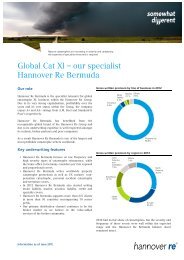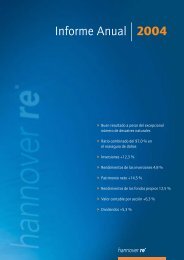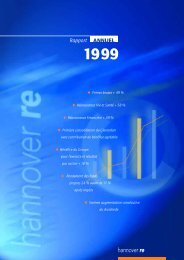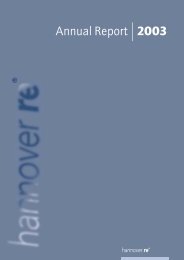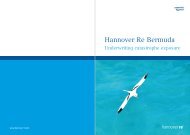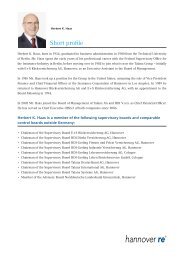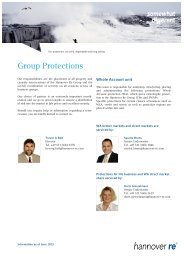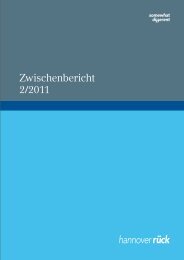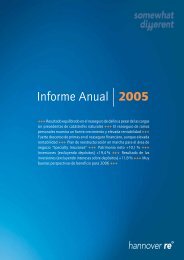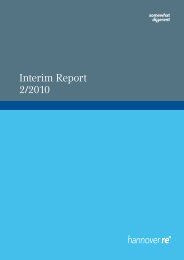Annual Report 2010 - Hannover Re
Annual Report 2010 - Hannover Re
Annual Report 2010 - Hannover Re
Create successful ePaper yourself
Turn your PDF publications into a flip-book with our unique Google optimized e-Paper software.
Fair value: price at which a financial instrument would be<br />
freely traded between two parties.<br />
FASB Accounting Standards Codification, FASB ASC: since 15<br />
September 2009 the single source of authoritative US GAAP.<br />
It is a codification of all previous standards.<br />
Financial Accounting Standards Board (FASB): committee in<br />
the USA whose task is to determine and improve upon the<br />
standards of accounting and reporting.<br />
Financial Accounting Standards (FAS): cf. Statement of Financial<br />
Accounting Standards (SFAS)<br />
Financial Solutions: targeted provision of financial support for<br />
primary insurers through reinsurance arrangements under<br />
which the reinsurer participates in the original costs of an<br />
insurance portfolio and receives as a consider ation a share of<br />
the future profits of the said portfolio. This approach is used<br />
primarily for long-term products in personal lines, such as life,<br />
annuity and personal accident insurance.<br />
Free float: the free float refers to the part of the capital stock<br />
held by shareholders with a low stockholding in both absolute<br />
and relative terms.<br />
Funds held by ceding companies/funds held under reinsurance<br />
treaties: cf. deposits with ceding companies/deposits<br />
received from retrocessionaires<br />
Goodwill: the excess of the cost of an acquired entity over the<br />
net of the amounts assigned to assets acquired and liabilities<br />
assumed.<br />
Gross/<strong>Re</strong>tro/Net: gross items constitute the relevant sum total<br />
deriving from the acceptance of direct insurance pol icies or<br />
reinsurance treaties; retro items constitute the relevant sum<br />
total deriving from own reinsurance cessions. The difference<br />
is the corresponding net item (gross – retro = net, also: for<br />
own account).<br />
Impairment: extraordinary amortisation taken when the<br />
present value of the estimated future cash flow of an asset is<br />
less than its book value.<br />
International Accounting Standards (IAS): cf. Inter national<br />
Financial <strong><strong>Re</strong>port</strong>ing Standards (IFRS)<br />
International Accounting Standards Board (IASB): committee<br />
in the EU whose task is to determine and improve upon the<br />
international standards of accounting and reporting.<br />
International Financial <strong><strong>Re</strong>port</strong>ing Standards (IFRS): stand ards<br />
published by the International Accounting Standards Board on<br />
accounting and reporting (until 2002 they were named International<br />
Accounting Standards, IAS).<br />
International Securities Identification Number (ISIN): tencharacter<br />
universal code used to identify securities internationally.<br />
It is prefixed by a country code that specifies the<br />
country where the issuer entity is legally registered or in<br />
which it has legal domicile, e.g. DE = Germany.<br />
Intrinsic value creation (IVC): the IVC is calculated accord ing<br />
to the following formula: real operating value creation = adjusted<br />
operating profit (EBIT) – (capital allocated x weighted<br />
cost of capital). IVC is a tool of value-based enterprise management<br />
used to measure the accomplishment of long-term<br />
targets on the level of the Group, the individual business<br />
groups and the operating units (profit centres).<br />
Investment grade: investment grade ratings are awarded to<br />
companies and assigned to securities that have a low risk profile.<br />
They contrast with non-investment-grade rat ings, which<br />
by definition include speculative elements and therefore entail<br />
a significantly higher risk.<br />
IVC: cf. Intrinsic Value Creation<br />
Issuer: private enterprise or public entity that issues securities,<br />
e.g. the federal government in the case of German Treasury<br />
Bonds and a joint-stock corporation in the case of shares.<br />
Hybrid capital: debt structure which because of its subordination<br />
bears the character of both debt and equity<br />
IBNR (Incurred but not reported) reserve: provision for claims<br />
which have already occurred but which have not yet been<br />
reported.<br />
Leader: if several (re-)insurers participate in a contract, one<br />
company assumes the role of leader. The policyholder deals<br />
exclusively with this lead company. The lead (re-) insurer normally<br />
carries a higher percentage of the risk for own account.<br />
Letter of credit (LOC): bank guarantee; at the request of the<br />
guaranteed party, the bank undertakes to render payment to<br />
the said party up to the amount specified in the LOC. This<br />
method of providing collateral in reinsurance business is typically<br />
found in the USA.<br />
198 Glossary<br />
<strong>Hannover</strong> <strong>Re</strong> Group annual report <strong>2010</strong>



